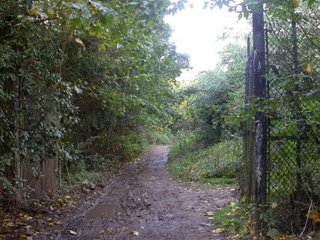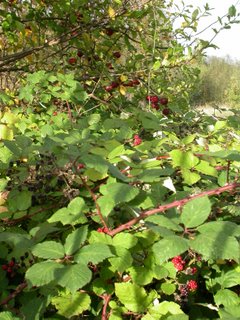
Large Redrow signs and banners on the main road – Garston Way – telling all who pass that the sales office is open.
All who might be passing in a posh car – perhaps – but obviously not those of us who try and reduce our carbon emissions.
I appreciate the cycling trousers and a billowing cagoule are not the most flattering of attire, and wind does no favours for any type of hair do – or eye make-up - which, if I were to wear any on my travels would no doubt slip from where it should be and make it’s way in a streaky fashion down my cheeks as eyes water from wind in the face…
Practicality on a bike is essential – and being practical doesn’t mean I, or anyone else, should automatically be judged as a ‘trespasser’.
How it happened was…
I cycled down the new road to the show homes.
I heard a whistle – the kind of loud whistle made from putting forefinger and little finger into your mouth and blowing hard
“How rude” I thought as I heard the load whistle, assuming a salesperson was whistling to attract the attention of a fellow colleague. Indeed he was – but the colleague was a burly chap being summoned to undertake the task of ejecting me from the area.
“I’m looking at the houses that are for sale.” I say in a meek and sweet voice.
“Then you should be in the sales office” he grunted back at me, all stony faced.
I wheel my bike up to the office, and walk inside to be greeted by a lady who looked like she would have been happier talking to a dog pooh on her shoe.
I try my best to have a civil conversation with the sales woman - not easy.
As I am looking at the plan layout of the estate I notice a mini roundabout with the word ‘ART’ in its centre.
“Ohh” I say – “is there an artwork planned for there?”
“Yes”
“Is it under Section 106 and the percent for art scheme?”
“Yes”
“Oh, I’m an artist, and I’ve worked on percent for art schemes”
This was not the right thing to say… from the look on her face I think she now thought that I was not only dirty scum, but also a liar…
But I persevere
“Who’s doing it – do you know”
“Yes, it’s Dot-art. They have taken over one of the show homes and turned it into a gallery.”
I don’t want to say anything about the exhibition except it too is in the Independents Biennial
So where was their Independents Biennial cone?
From the web site www.artinliverpool.com Liverpool Biennial 2006 Blog
"Dot-art Group Show in Cressington Show Home
Dot-art launched a group exhibition of work by local artists on Saturday, in the unusual location of a 4 bedroom show home, at Redrow's Cressington heath development in Garston.
The show was launched with an open day complete with Hot Air Balloon.
Click the link below for map and directions.
http://www.redrow.co.uk/developments/gettingthere/40.
If you decide to go and see the exhibition – perhaps you might like to give some thought to how you get there and how you dress…




















































